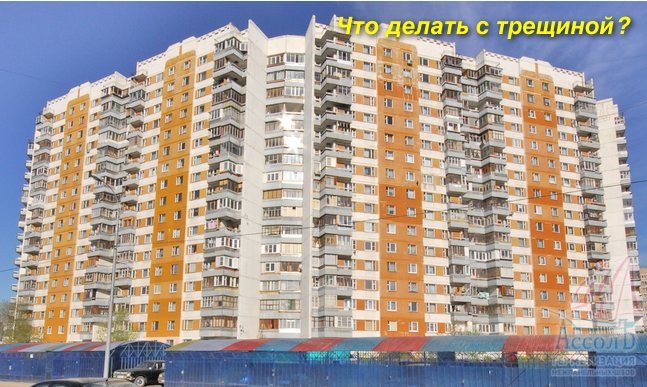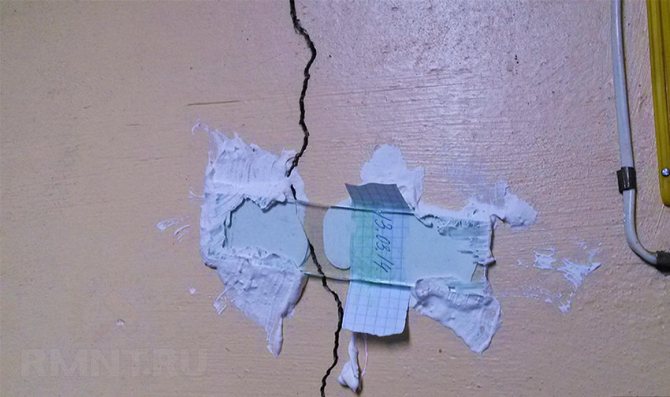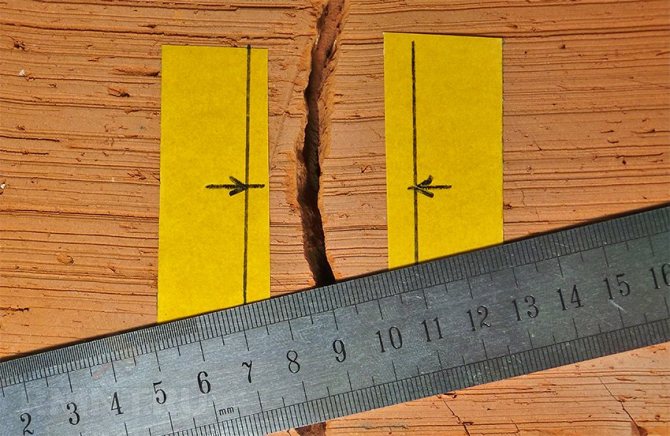When do cracks occur?
Cracks that are less than one millimeter thick are not a cause for concern. In the P-3 series, for example, the presence of cracks on the top floors and technical floors is caused by cracking of the outer plaster or putty layer intended for painting. It looks terrible. But precipitation does not penetrate into the panel. It is advisable to carry out cosmetic sealing. cracks to stop further cracking. The work is carried out by industrial climbers. The material for sealing crack seams is sealant for interpanel seams. This service can be ordered by calling the company and is called sealing crack seams). On average, 30 linear meters are required for a 2-room apartment. The cost of 1 linear meter is 300 rubles. It turns out an average of 105,500 with the price of slaves and materials. Causes of cracks in walls
Insufficient bearing capacity of the soil foundation of the structure and changes in the soil under the structure, as well as the behavior of the building material under the influence of heat and moisture (shrinkage and swelling) as well as external influences, such as wind, rain and even busy traffic, this can also intensify the occurrence of cracks in individual elements of the building.
Is a crack dangerous?
The cracks mentioned are not dangerous. Even in houses that are more than a hundred years old, new cracks can form. The reason for this may be increased traffic, and changes in the structure of the soil due to increased humidity or, say, construction work on a neighboring site.
In new buildings, during the first five years of the building’s operation, this is a completely normal phenomenon, as shrinkage occurs.
But rebuilding or major reconstruction of a building is already dangerous.
The degree of danger is revealed as follows: climbers make marks from plaster or simply strips of special paper.
And within three to four weeks - CHECK whether a crack will appear on the plaster mark

If a crack appears, continue to monitor it for another eight to twelve weeks. And if it does continue to grow, be sure to contact a construction expert.
A specialist will suggest options for assistance based on the findings of whether the crack is developing further and how it affects the statics of the structure.
How to seal a gap
In construction practice, cement, rubber, polyurethane foam, sealant, and various types of mastics are used to seal cracks. Their goal is to evenly fill the space and prevent the penetration of moisture and wind into the rupture areas.
If damage to the load-bearing structures of an apartment building does not require major repairs, everyone has the opportunity to repair the damage using a grinder, chisel, hammer, spatula, sealant, masking tape and putty. To seal gaps in panel houses, you need to perform the following steps:
- Drill a hole along the edges of the crack (so that the source of destruction does not increase over time). When performing this operation, the fittings may be damaged. Vulnerabilities should be identified in advance.
- Using a chisel or grinder, create a 10 mm chamfer (beveled corners).
- Remove dust using a vacuum cleaner or broom.
- Treat the surface with a primer.
- After the primer has dried, you can stick on the paint mesh and apply putty. If the wall is cracked to a significant extent, you will need to fill the void with cement mortar.
- Re-prime the restored area. If the gap reappears, it is best to contact a specialist.
Related article: Fireproof materials for walls around furnaces
What to do with a crack

Cracks that do not grow or develop can be hidden using cosmetic methods.
Materials used are artificial resins or filling cements, sometimes deep penetration putties or dense primers.
Some problems that are associated with the reliability of certain buildings sometimes cause panic attacks in people. Such situations happen quite often, and one of them was voiced by the owner of an apartment in an old 9-story panel building:
We live on the 5th floor and both of our 2 rooms share an external wall. It is she who causes us great fear. We regularly hear clicks and crackling sounds, and this is especially noticeable at night. This situation has been going on for several months now, and now the appearance of strange sounds has become more frequent (it’s summer). There are no visible cracks in the wall. We are wondering whether it is worth continuing to live in our apartment or whether it is time to change our location before it is too late.

How to determine the type of crack
Cracks can be superficial, in which only the plaster layer cracks, or through, passing through the entire thickness of the wall. To determine the type of damage, it is necessary to determine whether the crack continues to grow or whether it has already established itself and does not change in size.
Related article: How to drill into a concrete wall with a regular drill
This is determined using glass beacons. A long narrow strip is cut out of thin glass, and its ends are fixed with plaster on both sides of the crack. The center portion should remain clean and sit on top of the crack. It is better to mix the gypsum thicker to make it easier to glue the glass. Its walls are so smooth that the ends of the glass lighthouse constantly slide off, so you need to hold it with your hands for a few seconds until the plaster hardens completely.

Signs of determining the depth of cracks:
- surface (removable by cosmetic repairs) - after a month the glass remains intact. Such a crack has already stopped and is not growing;
- destroying the house (requiring major repairs) - the glass burst within a month. The discrepancy continues and it is necessary to look for the causes of this process and urgently eliminate them.
The most common cause of such cracks is a violation of the integrity of the foundation and soil subsidence. Destructions occur when the soil is loose or the foundation area is small and not designed to support the weight of the walls. Sometimes the base is washed away by groundwater. If the strength and integrity of the foundation is not restored and further subsidence is not excluded, it will be impossible to repair the cracked wall. No matter how many times it is plastered and no matter how it is strengthened, the crack will appear again.

Causes of cod
It's quite simple. The problem lies in the interpanel seams, which are the weak point of such houses. As for the sounds themselves, they become stronger with a sharp temperature change, which can be observed in the summer. The walls get very hot in the sun during the day and cool down quickly at night. In such a situation, we can say with 90% confidence that the interpanel seam has exhausted its service life and has collapsed.
The cause of cracking in the walls can also be a slight movement of the panels that are connected to each other by welding. To find out exactly what is causing the unpleasant sounds, it is better to immediately call industrial climbers to inspect the wall. If the problem lies in the seams, it is necessary to seal them and restore them to their original condition. You will have to pay a lot for this, but now you can sleep peacefully.

What if the problem is not in the panel seams?
If during the audit no problems were found with the joints of the slabs, the cause of the sounds may be due to thermal expansion of reinforced concrete structures and their further sudden cooling. However, this is certainly not so easy to determine. It is likely that certain construction standards were violated during the construction of the house. In this case, it is worth protecting the wall from possible temperature changes, and the ideal way for this would be external thermal insulation. With her, the apartment will be warm in winter and cool in summer.
What do we offer
Our company can offer ]sealing of walls[/anchor] for high-rise work.
Teams of our industrial climbers work in Moscow and the Moscow region. Frequently asked questions about sealing seams: / The management company does not fulfill its obligations, where can I turn? / Practice of filing an application to the Court for sealing seams / Sample application to the Management Company for repair of interpanel seams / Secrets of correctly writing an application for interpanel seams in the Criminal Code / Who should repair a balcony in a privatized apartment? / List of basic works for routine repairs and operation of buildings and structures / Seams in a panel house are leaking, sample application / How to force the management company to seal interpanel seams? / Who should repair the interpanel seams in the house? / Seams in a panel house are leaking, sample application / Time frame for major repairs of interpanel seams
Cracks in the walls of a panel house
- home
- Services and prices
- Cracks in the walls of a panel house
10.10.2017
Author: Vladislav Bondarchuk
Has a crack been discovered in your home?
Don’t put off the problem, better call an expert for a free inspection!
By submitting contact information, you agree to the Privacy Policy
Cracks in panel houses are not uncommon. Almost everyone has seen buildings with grouted seams, and these houses have been standing like this for decades. Of course, if the split is through, and it blows, or moisture gets into the apartment, you need to do repairs, but in general, there is no particular reason to worry. Let's figure out why cracks can occur in panel walls, how dangerous they are in general, how to identify the risks, and what to do as a result.
Why do cracks appear in the walls of a panel house?
There is not and cannot be one reason. But there are the most common ones that most often cause cracking.
- House shrinkage
. The most common reason is in new buildings. On average, a house lasts about 5 years, and if you are planning a very expensive and complex renovation, it may be worth waiting this time so as not to have to redo everything later. - Redevelopment
. Most often, in panel houses, it is the internal walls that are load-bearing, and therefore it is not recommended to touch them at all - move openings, demolish them, etc. But the residents do this, and as a result the house warps from the uneven load. The problem especially often arises if redevelopment is done on the lower floors. - Violation of
construction technology. Sometimes a house is delivered with uneven panels and holes filled with caulk or other materials. For this reason, cracks appear at joints and corners. It happens that panels are already delivered with cracks, or they appear during the construction process. - Construction work next to the building
. When residential complexes are built, it happens that a dug ditch, foundation, or simply powerful vibration work causes problems with the foundation, and it begins to sag. - Grooving walls for hidden wiring
and air conditioner routes. The problem exists in many modern homes, and new residents are usually warned about the ban, but few take it seriously. As a result, cracks appear not only where the house shrinks logically, but also in unexpected places, and the load only increases.
How dangerous is a crack in the wall of a panel house: what to do to determine the risks?

The complexity of the problem depends on where exactly the crack originated: in an external or internal wall, or on the ceiling.
- Small external cracks
are not dangerous, and panel houses do not collapse from them, especially if the crack is on an external wall. Yes, it’s uncomfortable, it’s windy, but there’s no risk. Cracks that arise from the demolition of load-bearing walls on the first floors are dangerous. This happens when the first floors are purchased for a store or similar premises, and then redevelopment is done. - If a crack has occurred in the load-bearing wall between apartments
, you need to determine its depth to find out whether it is through, in which case it may be necessary to strengthen the wall. However, there is usually so much reinforced concrete that it can easily withstand a fault. Such cracks usually cause maximum excitement, and in this case, of course, there is no point in delaying. - Cracks in the ceiling
are not dangerous in principle, and usually cause only aesthetic indignation: no matter how hard the plaster is, it will break through under the wallpaper and paint. In this case, a suspended ceiling is usually recommended.
To determine the risk of developing and increasing a split, you can install a plaster beacon
. It should be about the size of your palm, and if the crack is tortuous, you will need to place several pieces in different places.
If the lighthouse does not collapse in 2-3 months
This means that the crack is not developing and can be repaired. If the crack grows, you must contact the appropriate authorities - the HOA or the Management Company, who will solve the problem, identify the cause and eliminate the risks.
Before taking any action to repair a crack, you need to identify the cause, so you will have to go through your neighbors’ apartments and be sure to see if any redevelopment has been done there. If you have a good relationship, they will probably let you in anyway, otherwise you will need to collect a commission.
Please note: representatives of the management company and the HOA must at least draw up an act, or better yet, install beacons and monitor their condition. If the situation is critical, the crack is large, and the management company and the HOA are doing nothing, file an application with the City Housing Inspectorate and wait for the commission to arrive.
How to repair cracks in panel walls yourself?

Previously, rubber and cement were used as sealing materials, today there are many modern solutions - polyurethane foam, mastics, sealants
. They fill the space and prevent water and wind from entering the house, and some also further strengthen the panel. You can find the right product at a hardware store.
To fill a crack, you need to clean it thoroughly
, it is possible to remove the old seam, wash and dry the edges, and beat them with a hammer for better bonding. Large cracks are usually foamed, small ones can simply be sealed with sealant, allowed to dry, and a solution applied. Depending on the situation, it is possible to use a construction mesh so that the wall does not collapse and the wallpaper does not lag behind it.
Please note that temperature is important
environment if you are repairing a crack in an exterior wall. It is advisable to do this in a warm house, but at least +5 degrees is already good. This is not the temperature outside, but rather the temperature of the panel itself. This way, all the products will adhere well, dry and not come off over time.
Who will pay for cracks in the walls of a panel house?
First you need to figure out who is to blame for the situation: the builders, the developer, the neighbors or someone else. But you need to understand that, as a rule, such cracks are not dangerous, and therefore the Housing Office in this case often sends a formal reply: there is a crack, we will repair it, your house will be in line in 20 years.
The most realistic way to obtain compensation is from neighbors or the developer, but you will have to do this through the courts
.
Most residents have to carry out routine repairs at their own expense, since they don’t want to live in a drafty room with mold and torn wallpaper.
In any case, with non-dangerous, stable cracks, there is time to save money and make repairs.
Has a crack been discovered in your home?
Don't put off the problem.
Hurry up to take advantage of the free inspection until October 31st! By submitting contact information, you agree to the Privacy Policy
Author of the article
Vladislav Bondarchuk
Melwood company expert
Spent 267
construction examination,
31
forensic examinations
In company with 2017
of the year
You can email [email protected]
Related articles:
- Examination of cracks in buildings and structures
- Cracks in monolithic walls
- Cracks in brick walls: causes and elimination









